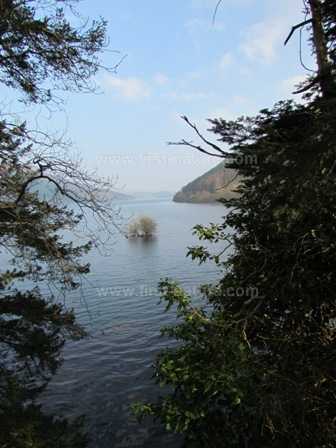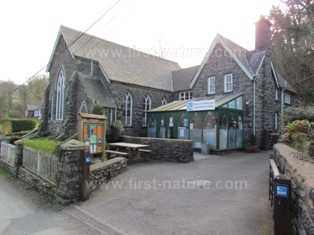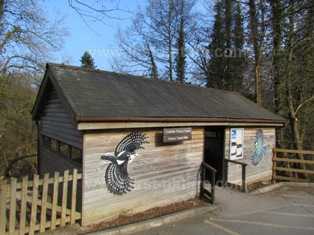Trees Birds Mammals Fish Amphibians Reptiles
Wild Algarve
Bookshop




Lake Vyrnwy RSPB Reserve, Near Welshpool, East Wales
Designations: part of the Y Berwyn NNR; within the Berwyn SSSI and SPA as well as Berwyn and South Clwyd Mountains SAC
Below: A view across Lake Vyrnwy in early spring

We have many beautiful lakes in Wales, but if we were to hold a competition for the title of 'most beautiful' then Lake Vyrnwy would surely be a very strong contender.
The RSPB Reserve at Lake Vyrnwy is easily accessible. There is a circular route running around the whole of the lake and from which vantage points along this route it is possible to see some of the many 'picture postcard views' that have made this lake so famous. It's not just the presence of the lake that makes Vyrnwy such a magnet for birds, however; the wooded shores are home to numerous breeding birds, particularly during the spring and summer months.
As a further attraction, if you visit Lake Vyrnwy RSPB Reserve in autumn the woodlands are full of fungi.
The reserve is managed by RSPB and Severn Trent Water.
Directions
Grid Ref: SJ016192
From Welshpool take the A490 northwards for approximately 15km (10 miles) and, after passing through through Llanfyllin, turn left onto the B4393 to Llanwyddyn.
When you reach the dam at the eastern end of Lake Vyrnwy, turn left, drive across the dam and then turn left again at the junction on the other (southern) side of the dam.
The RSPB Visitor Centre and shop are on the right hand side; the contact details are RSPB, Bryn Awel, Llanddwyn, Oswestry SY10 0LZ Telephone: 01691 870 278.
Access
There are a number of nature trails throughout the reserve and information and leaflets are available from the Visitor Centre. There is a wheelchair-accessible birdwatching hide beside the Visitor Centre car park, and from this vantage point it is possible to observe woodland birds such as Siskins and Nuthatches. There are two other hides overlooking the lake, providing opportunities to see water birds such as Common Sandpiper, Goosander and Great Crested Grebe.
Below: The RSPB Visitor Centre and Shop at Vyrnwy

Facilities
There are a number of helpful information boards close to the Centre which also show the trails and the bird species that you can expect to see at Lake Vyrnwy. There are a café, public toilets, a Visitor Centre and a shop.
Description of Site
Lake Vyrnwy lies within a Special Area of Conservation and the habitats there, including a working farm, are managed for the benefit of birds and other wildlife.
The programme of habitat improvements involves mowing and grazing so that the dry heaths are suitable for birds such as Ring Ouzel (Turdus torquatus), Red Grouse (Lagopus lagopus), and Curlew (Numenius arquata).
The blanket bog is also maintained by working to block up old drainage channels that were originally dug to drain the land for agricultural purposes. Without the right water level the bog cannot support the unique range of plants, insects and animals that depend on it for their survival. Blanket bogs are wide tracts of acid peat land that occur only in places where there is a lot of rain. Plants that grow in blanket bog include Bog Rosemary (Andromeda polifolia) and Hare's-tail Cottongrass (Eriophorum vaginatum), along with more common species of heathers. Round-leaved Sundew (Drosera rotundifolia) a carnivorous plant also grows in the bog, where it feeds partly on the myriads of small insects that live in such wet, vegetation-rich places.
Below: The RSPB bird hide - the feeding station is directly in front of it.

Woodland projects are being carried out aim to extend the woods. This entails introducing broad-leaved trees into the nearby conifer plantations. This work, together with a number of other management measures such as leaving fallen deadwood in the woodland and pollarding damaged birch trees, will make the area suitable for a wider range of plants, animals, fungi, birds and insects.
The special woodland bird species that will benefit from this work include Pied Flycatchers (Ficedula hypoleuca), Nightjars (Caprimuglus europaeus), Bullfinches (Pyrrhula pyrrhula), Great Spotted Woodpeckers (Dendrocopus major) and Lesser Spotted Woodpeckers (Dendrocopus minor), all of which are already present at Lake Vyrnwy and the subject of close monitoring to record trends in their numbers.
In spring the migrant birds begin arriving for their breeding season, and around the lake below the dam you may see Dippers, Grey Wagtails and Common Sandpipers. Great Crested Grebes can also be seen on the lake as they engage in their marvelously choreographed mating displays.
As summer progresses the feeding station close to the Visitor Centre becomes a handy place for fledglings (and their parents) to pop in for a meal, and there you can expect to see Great Spotted Woodpeckers perched on the nut feeders. The colours of the young birds are not nearly as distinct as their parents, but this gradually changes with the somewhat beige feathers eventually becoming white. Don't forget to look up as well as around you: then you may see some of the rare raptors that fly over Lake Vyrnwy, such as Merlins (Falco columbarius) Peregrine Falcons (Falco peregrinus) and Hen Harriers (Circus cyaneus).
Autumn and winter are the times to visit to see wildfowl on the lake, with the arrival of Mallards, Teal and Little Grebes. At this time other parts of the reserve become home to Bramblings (Fringilla montifringilla), Fieldfares (Turdus pilaris) and Redwings (Turdus iliacus).